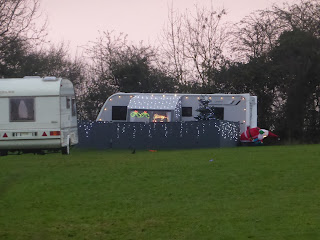We did this final
section of the walk on Saturday 31st December 2016 – New Years Eve. Just a few days before we did not think we
were going to meet our target of finishing before the end of the year but now
it was reality. The weather
was mild and dry but very misty when we started. Towards the end the sun came out and it
turned into a bright afternoon.
Claybrooke Magna to Frolesworth
 |
| Bell Lane, Claybrooke Magna |
The route took us straight out of Bell Lane, Claybrooke Magna near to where we had entered it, so no chance to see any of the village without a detour.
 |
| Claybrooke Mill Stream away from the Mill |
We walked through a grassy
field and then over crop fields to Claybrooke Mill. We didn’t see the actual mill but crossed a
bridge over the mill stream and got a glimpse of the secluded mill house together with a
family of ducks on the water.
 |
| Claybrooke Mill Stream looking towards the Mill |
There was a short walk from the mill up to cross the road between Frolesworth and Claybrooke Magna. We had a good view across to Claybrooke Magna as the mist started to lift.
 |
| View to Claybrooke Magna, where we started today |
 |
| Fishing Lake at Manor Farm, Frolesworth |
The onward path took us around stables and up to a farm track from where we had good views over a fishing lake at Manor Farm.
We arrived
in the village of Frolesworth and looked back to get good views of the
surrounding countryside over which we had just walked.
 |
| View from Frolesworth over surrounding countryside |
Frolesworth is a very small village with about 80 properties. It has a single road and most of the houses are either on this road or slightly set back from it. At
the centre of the village is St Nicholas Church which dates back to the 13th
century. The church commands the highest ground in the village.
 |
| Oak Tree planted in 2012 to commemorate The Queens Diamond Jubilee |
 |
| St Nicholas's Church, Frolesworth |
Frolesworth to Leire
We walked along the road through
Frolesworth passing the church on our right and a tree planted to commemorate the Queens Diamond Jubilee in 2012. After leaving the village
we were soon back across fields making towards the village of Leire. We gradually moved away from the road and up
over a hill from where we could see the spire of Leire church. We crossed a few more muddy fields and
arrived in the village having crossed a strip of land where the former Midland
Counties Railway used to run.
 |
| The Midland Counties Railway used to run along this strip of land |
Leire is a small village with a population of about 500 according to the 2011 census. The name is thought to originate from the pre-English name for the nearby River Soar – The Legra, a tributary which has its source to the south of the village.. The village church of St. Peters dates back to the 14th century. There are 2 pubs, the Queens Head and the Crab and Cow, formally the White Horse.
 |
| Attractive front garden in the vilage |
The village used
to have its own railway station – Leire Halt – on the former Midland Counties
Railway running from Leicester to Rugby.
It was opened in 1925 and closed, along with the whole line in 1962. Part of it has been turned into the Jubilee
Nature Walk running south towards Ullesthorpe.
Leire to Dunton Bassett
 |
| The Crab and Cow pub in Leire, formally the White Horse |
We stopped at a seat in Leire and had a drink and snack before continuing past the Crab and Cow and then down Stemborough Lane towards Stemborough Mill. There were now a lot more breaks in the cloud and the sun started to shine.
Stemborough Mill House is a grade II listed building and sits alongside a trout farm. We crossed the stream which runs from the Trout Lakes to Broughton Astley via our garden. Trout do escape from the farm occasionally and we have seen them in the part of the stream that runs through our property.
 |
| Stemborough Mill House |
 |
| Stemborough Mill Trout Farm Lakes |

The final leg of our walk took us past the trout lakes and alongside farmland, where there were grassy areas to walk on and up a grass field into Dunton Bassett, back where we had started our Leicestershire Round walk over 9 months earlier on 27th March 2016.
 |
| Nearly there - Dunton Basset Church comes into view |
Dunton Bassett is a small village lying close to the M1 motorway. It has one pub - The Dunton Bassett Arms or DBA and the village church is All Saints. The Great Central Railway, the last main line to be built from the North to London in 1899 ran just to the east of Dunton Bassett. There was a station but its name was given to nearby Ashby Magna. A short tunnel to the south was named the Dunton Bassett Tunnel. In later years the M1 was built to run parallel to the railway which closed on 5 May 1969.
Distance
We walked a
total of 5.65 miles and did about 14,000 steps.
We have now completed
the Leicestershire Round as we intended, within the year 2016.





























